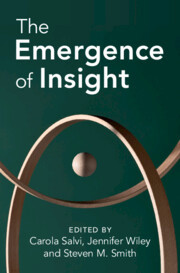The Emergence of Insight
Langue : Anglais
Coordonnateurs : Salvi Carola, Wiley Jennifer, Smith Steven M.

We are all familiar with the feeling of being stuck when a problem we are faced with seems intractable and we are unable to find a solution. But sometimes, a new way of seeing the problem pops into the mind from out of the blue. The missing piece of the puzzle is found, the gap is filled, and the solution is now obvious. This is the insight experience - the Aha! Moment - which has been a source of fascination to those who study problem solving for centuries. Written by leading researchers from around the world, this volume explores cutting-edge perspectives on insight, the processes that underlie it, and the conditions that promote it. Chapters draw on key themes: from attention, to memory and learning, to evolutionary perspectives. Students and researchers in applied, cognitive, and educational psychology, as well as those studying creativity, insight, and cognitive neuroscience, will benefit from these perspectives.
Part I. Introduction: 1. Introduction to emergence of insight Steven M. Smith, Jennifer Wiley and Carola Salvi; Part II. Fixation and Insight: 2. The past and future of research on so-called 'Incubation' effects Steven M. Smith and Zsolt Beda; 3. Forgetting and inhibition as mechanisms for overcoming mental fixation in creative problem solving Benjamin C. Storm and Mercedes T. Oliva; 4. Overcoming interna and external fixation in problem solving Rebecca Koppel, Tim George and Jennifer Wiley; 5. How impasse leads to insight and innovation in problem solving Colleen M. Seifert; Part III. Pathways to Insight: 6. The role of curiosity1 and curiosity2 in the emergence of insight William James Jacobs and Janet Metcalfe; 7. Mind wondering: Curious daydreaming and other potentially inspiring forms of mind wandering? Jonathan W. Schooler, Madeleine E. Gross, Claire M. Zedelius and Paul Seli; 8. Jumping about: the role of mind wandering and attentional flexibility in facilitating creative problem-solving Nicholaus P. Brosowsky, Madeleine E. Gross, Jonathan W. Schooler and Paul Seli; Part IV. After Insight: 9. The adaptive function of insight Ruben E. Laukkonen; 10. The insight memory advantage Amory Danek and Jennifer Wiley; Part V. Cognitive Neuroscience of Insight: 11. Waves of insight: The history of research on insight and its neural components Christine Chesebrough, Carola Salvi, Mark Beeman, Yongtaek Oh and John Kounios; 12. Why my 'Aha!' is your 'Hmm….': Individual differences in the phenomenology and likelihood of insight Christine Chesebrough, Yongtaek Oh and John Kounios; 13. Insight, what happens backstage? Carola Salvi and Edward Bowden; Part VI. Conclusion: 14. Insights from the emergence of insight Jennifer Wiley, Carola Salvi and Steven M. Smith.
Carola Salvi is an Associate Professor at John Cabot University of Rome, Italy and Faculty Affiliate at the University of Texas at Austin, USA. She studies the neural mechanisms underlying problem solving, creativity and cognitive flexibility. She pioneered the discovery of the 'accuracy effect' of insight and studied its relationship with the sensory system, the involvement of the right temporal lob (using brain stimulation and imaging), and the dopamine system.
Jennifer Wiley is Professor of Psychology at the University of Illinois at Chicago, USA. She studies learning, comprehension, metacomprehension, and problem solving. Her research on creativity has explored how expertise can both enable and hinder finding novel solutions, the tension between being able to resist distraction and too much attentional control, and how collaboration can support deeper understanding and innovation.
Steven M. Smith is Professor at Texas A&M University, USA. He has applied his research to eyewitness memory, engineering design, patent law, and humanꟷcomputer interaction. He co-authored the foundational book Creative Cognition: Theory, Research, and Applications (1992), has written numerous transformational papers on context-dependent memory and design fixation, and has delivered invited addresses around the world.
Jennifer Wiley is Professor of Psychology at the University of Illinois at Chicago, USA. She studies learning, comprehension, metacomprehension, and problem solving. Her research on creativity has explored how expertise can both enable and hinder finding novel solutions, the tension between being able to resist distraction and too much attentional control, and how collaboration can support deeper understanding and innovation.
Steven M. Smith is Professor at Texas A&M University, USA. He has applied his research to eyewitness memory, engineering design, patent law, and humanꟷcomputer interaction. He co-authored the foundational book Creative Cognition: Theory, Research, and Applications (1992), has written numerous transformational papers on context-dependent memory and design fixation, and has delivered invited addresses around the world.
Date de parution : 05-2024
Ouvrage de 334 p.
Thème de The Emergence of Insight :
© 2024 LAVOISIER S.A.S.



